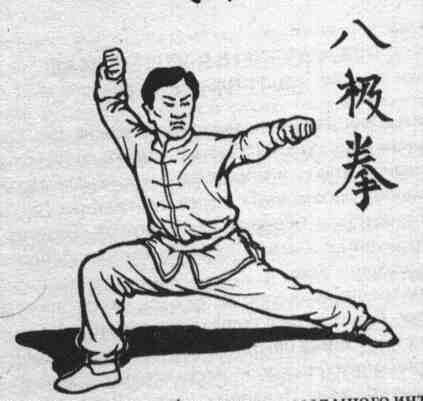|
|
|

Full name of this style is "kaimen baji quan" ("Fist of Opening Gates of Ejght Limits"), another name - "Yueshan baji quan" ("Yueshan's Fist of Eight Limits").
Word "kaimen" ("opening the gates") is used because the sense of technique is six methods of opening ("liu da kai" - "six big opennings"), intended for break the doors (i.e. defence) of enemy. Term "baji" is very old. "Huainanzi" says: "Beyond nine regions [of ancient China] there exist eight spaces, beyond eight spaces there exist eight stretchings, beyond eight stretchings there exist eight theirs limits". "Houhanshu" says: "Big roads stretch far, reach eight limits". Word "Yueshan" is used due to legend says that bajiquan origins from Yueshan temple of Jiaozuo county of Henan province.
In old time "bajiquan" also was written as "bazi quan" ("Fist of Targets") or "bazi quan" ("Fist of Hyerogliph `Eight'"). In the book "Jixiao xinshu" (Ming dynasty) in "Fist's canon" chapter there exist words "bazi quan gun".
Bajiquan's creator is unknown. During Qing dynasty most bajiquan's fighters lived in Cang county of Hebei provunce. In neighbour counties Yanshan, Nanpi and Ninqjin there also were people studied bajiquan.
Chronicles contain two versions of bajiquan's creation. "Cangxian zhi" ("Chronicles of Cang county") says, that some taoist named Lai quring Qing dynasty since 51st year of reign under the motto "Kangxi" (i.e. since 1712) 10 years taught martial art, his student was Wu Zhong from Houzhuangke village of Dayun county of Hebei province.
Due to another version taoist named Zhang was an abbat of Yueshan temple in Jiaozuo county of Hebei province. When temple was burned he leaved temple. Once he saw how Wu Zhong teach "100 movements of eight poles". He caught a big pole and thrusted Wu Zhong's pole. Wu Zhong stopped teaching and became study bajiquan. He learned bajiquan and daliuhegun (big pole of six coordinations).
When Wu family moved to Mengcun village of Cang county, this place became a centre of spreading bajiquan. Wu Zhong transferred style to his daughter, Wu Rong. After Wu Rong bajiquan was divided on two branches. First branch - members of Wu family and their students. The famous masters of this branch in our days are Wu Nan and Wu Shike. Their relatives produced a great influence on Ma Fengtu. Another branch was created when Wang Si studied bajiquan in Mengcun and transferred it to Zhang Keming from Luotong village, Zhanf taught Huang Sihai and his own son Zhang Jingxing.Zhang Jingxing taught many people, famous are Li Shuwen, Ma Yingtu, Han Huachen, Zhang Yuheng (son of Zhang Jingxing). Li, Ma and Han spreaded Mengcun's bajiquan through whole China.
Bajiquan's movements are laconic, long and short are used parallel. Beginning of the movement is sharp, elbows are used very often, lower part of body is stable. Used kings of force: beng (collapse), han (shake), tu (break through), ji (hit), ai (push trough), chuo (thrust in), ji (press out), kao (lean on), zhuangkaojing (force of pushing and leaning) and chuankunjing (force of winding round and tie); there exist specific breathing coordinated with throw of power. Movements are quick and powerful.
Forms of body using rule "keep the body straight, use spine as axis". Forms of step: mabu, banmabu, gongbu, xubu. Kinds of moving: nianbu (mill step) and mobu (rub srep). Combat principles: da (hit), shuai (throw arm like wheep), na (grasp, catch), tui (push). Many movements use shoulders, back, elbows, pelvis. Sets are short but rich. Basic set is liudakai ("6 big openings", in another writing - "making 6 holes") - means ding (thrust by elbow or knee), bao (embrace), dan (carry on the pole or yoke), ti (hold, carry), kua (step over) and chan (wind round); another basic set is badazhao ("8 big methods"). Bajiquan's sets: liuzhoutou ("6 ends of elbows"), baji xiaojia ("small set of bajiquan"), yingshouquan ("fist of answering hands", contains 48 big blocks and 64 hand methods), bajiquan (another name baji duijie - "2-men set of bajiquan"), gonggong baji ("bajiquan of steel working"), baji shuanggui ("2 ruts of bajiquan") and so on. Weapon sets: yezhan dao ("broadsword of night fighting"), ti liu piaoyao dao ("carring the broadsword of fluttering willow"), liuhe daqiang ("big spear of six coordinations"), liuhe huaqiang ("blossom spear of six coordinations"), lianhuan jian ("continuous sword"), jiugong chunyan jian ("sword og nine palaces of pure yang"), danzhi gou ("sole hook"), baji jian ("sword of baji"), and 2-men sets - duizha daliuheqiang ("mutual thrusts by big spears of six coordinations") and yezhan jiumen shisan daodian ("thrusts of 13 broadswords of 9 gates of night fighting").